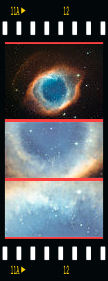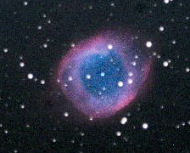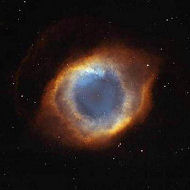 In
In 1827 Karl Ludwig Harding published his survey catalog of 120,000 stars (on 26 sheets) in
Atlas novus coelestis. It was during this survey that he found eight nebulae which he listed in the Astronomisches Jahrbuch of 1827 as being unknown. As it turned out, only one, NGC 7293 was an orignal discovery, made prior to 1824, which he located at RA 334:30 Dec. -21:45. Harding is most noted for his discovery of the asteriod 3 Juno on September 1, 1804 from the Sternwarte Lilienthal, the private observatory of astronomer Johann Hieronymus Schröter whom hired Harding in 1796. During the 1790's Schröter found himself defending his observations and interpretations of the presumed Venusian mountains, "backed quietly by his assistant Karl Ludwig Harding (1765-1834) who also noted and confirmed the phenomena. Harding was also a noted keen observer and later became the Professor of Astronomy at the German University of Göttingen..." Karl Ludwig Harding died in Göttingen on August 31, 1834. Both the moon crater
Harding and asteroid
2003 Harding are named in his honor. [1] - [3]

Credit: WFI, MPG/ESO 2.2-m Telescope, La Silla Obs., ESO -- Image: APOD
With the advent of the Hubble, Spitzer, the ESA's Infrared Space Observatory as well a newer more advanced ground based telescopes, object imaging has resolved a large number of complex questions. Conversely, it has created quite a few, especially when it comes to viewing the small myteriously formed details within the Helix Nebula:
"At first glance, the Helix Nebula (aka NGC 7293), looks simple and round. But this well-studied example of a planetary nebula, produced near the end of the life of a sun-like star, is now understood to have a surprisingly complex geometry. Its extended loops and comet-shaped features have been explored in Hubble Space Telescope images. Still, a 16-inch diameter telescope and camera with broad and narrow band filters was used to create this sharp view of the Helix. The color composite also reveals the nebula's intriguing details, including light-year long, bluegreen radial stripes or spokes that give it the appearance of a cosmic bicycle wheel. The spoke features seem to indicate that the Helix Nebula is itself an old and evolved planetary nebula. The Helix is a mere seven hundred light years from Earth, in the constellation Aquarius." [4]
 In 1827 Karl Ludwig Harding published his survey catalog of 120,000 stars (on 26 sheets) in Atlas novus coelestis. It was during this survey that he found eight nebulae which he listed in the Astronomisches Jahrbuch of 1827 as being unknown. As it turned out, only one, NGC 7293 was an orignal discovery, made prior to 1824, which he located at RA 334:30 Dec. -21:45. Harding is most noted for his discovery of the asteriod 3 Juno on September 1, 1804 from the Sternwarte Lilienthal, the private observatory of astronomer Johann Hieronymus Schröter whom hired Harding in 1796. During the 1790's Schröter found himself defending his observations and interpretations of the presumed Venusian mountains, "backed quietly by his assistant Karl Ludwig Harding (1765-1834) who also noted and confirmed the phenomena. Harding was also a noted keen observer and later became the Professor of Astronomy at the German University of Göttingen..." Karl Ludwig Harding died in Göttingen on August 31, 1834. Both the moon crater Harding and asteroid 2003 Harding are named in his honor. [1] - [3]
In 1827 Karl Ludwig Harding published his survey catalog of 120,000 stars (on 26 sheets) in Atlas novus coelestis. It was during this survey that he found eight nebulae which he listed in the Astronomisches Jahrbuch of 1827 as being unknown. As it turned out, only one, NGC 7293 was an orignal discovery, made prior to 1824, which he located at RA 334:30 Dec. -21:45. Harding is most noted for his discovery of the asteriod 3 Juno on September 1, 1804 from the Sternwarte Lilienthal, the private observatory of astronomer Johann Hieronymus Schröter whom hired Harding in 1796. During the 1790's Schröter found himself defending his observations and interpretations of the presumed Venusian mountains, "backed quietly by his assistant Karl Ludwig Harding (1765-1834) who also noted and confirmed the phenomena. Harding was also a noted keen observer and later became the Professor of Astronomy at the German University of Göttingen..." Karl Ludwig Harding died in Göttingen on August 31, 1834. Both the moon crater Harding and asteroid 2003 Harding are named in his honor. [1] - [3]



